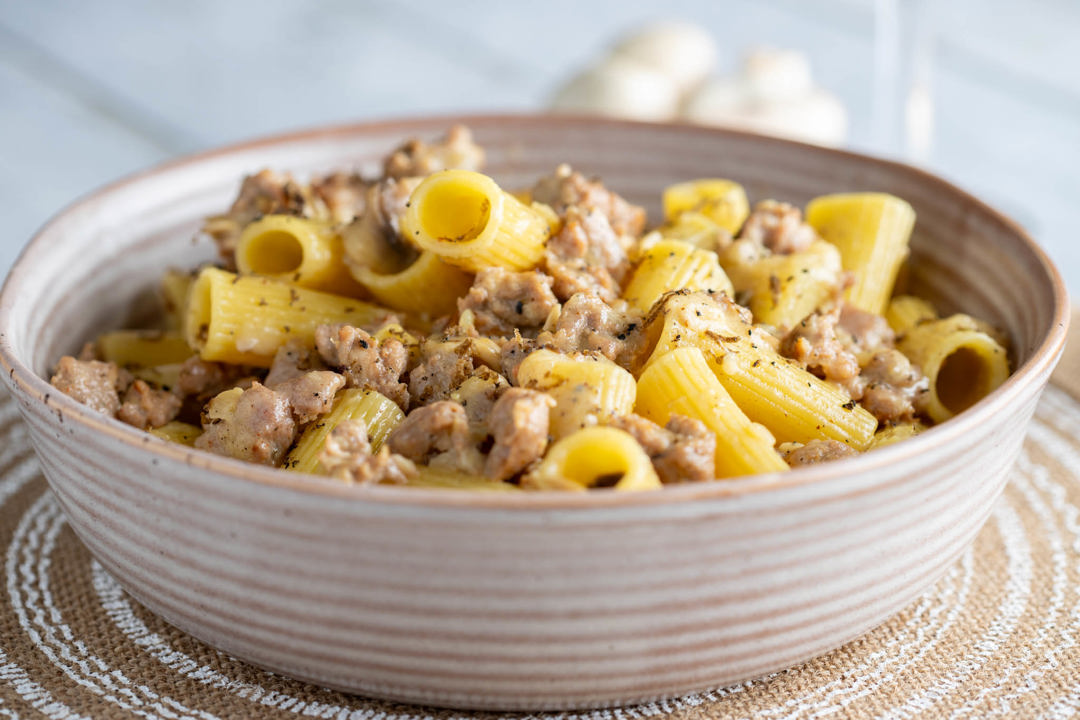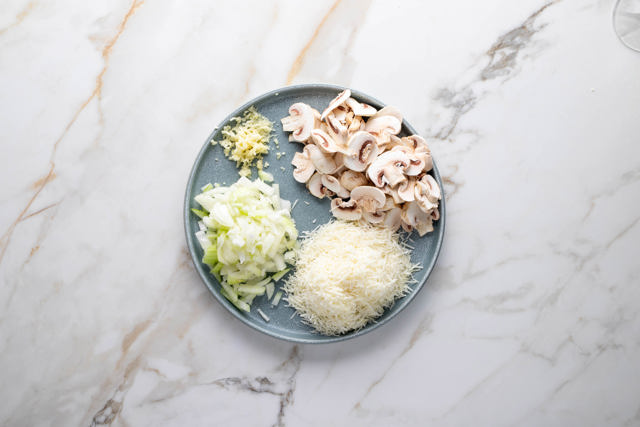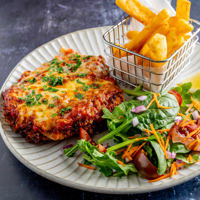Hailing from the town of Norcia in Umbria, Italy, this is a creamy pasta made with the local pork sausage, mushrooms, white wine, black truffles (optional but highly recommended) and other flavourings.
Simple to make, this is a great weeknight pasta. And if you choose to add the truffles - another staple of Norcia - it's perfect as part of a dinner party or date night meal.
This is not a particularly well known dish outside of Italy; I don't know why as it hits the mark with all of the flavours and textures. I first came across it while researching sausage pastas and it's been super popular in our house every time I've made it.
Pasta alla Norcina ingredients
- Pasta - this dish works well with short tubular pasta; penne, rigatoni, even fusili. Use whichever short pasta you prefer. As always, I recommend quality Italian dried pasta and preferably one made from a bronze die - such pasta is labelled as such as it yields a superior result. This also works well with gnocchi.
- Sausage - traditionally this is made with a Norcina sausage. I can't find this anywhere in Australia, but I do know from research that fennel should not be a dominant flavour, so try and find a plain Italian sausage. See notes later in this post.
- Mushrooms
- Cream
- Pecorino Romano cheese. Parmesan is not a substitute but if you can't find it feel free to use a quality aged parmesan. Pecorino is saltier so you will need to adjust salt levels accordingly.
- Garlic and Onion bring the aromatic smell and taste.
- A dry white wine.
- Truffles are traditionally grated or sliced over the top. There's no getting around it, they're a luxury ingredient and can be challenging to source and are expensive. Don't feel compelled to use it, but know that if you have the means to source a truffle that it pairs well with this dish.
How to make Pasta alla Norcina
Prepare ingredients according to instructions (1). Remove the casing from the sausage by making a shallow cut with a sharp knife from one end of the sausage to the other (2). Peel back the casing gently, using your fingers to separate it from the sausage meat, and slide it off gradually along the length of the sausage. Handle the casing carefully to avoid tearing it. Place the sausage meat on a plate.
Bring a pot of water to the boil for the pasta.
Cook onion - add the oil to a large pan and heat over medium. When the oil is warm and has started to shimmer add the onion. Cook until translucent and tender - about 3 minutes.
Add mushroom - add the mushroom to the onions (1) and cook until the mushrooms have lost their water and are tender (2) - about 2 minutes.
Add garlic to the pan and cook, stirring, until fragrant - about 30 seconds.
Cook sausage - add the sausage to the pan (1) and increase heat to medium high. Use your wooden spoon to break the sausage apart and stir (2). Continue doing this while the sausage is cooking while you move on to cook the pasta.
Cook pasta - add the pasta to the boiling water and season according to packet instructions.
Add wine - when the sausage is browned and cooked through, add the wine (1). Use your spoon to scrape the bottom of the pan and continue to stir occasionally while it mostly evaporates (2).
Add cream - reduce heat to medium and add the cream. Stir well to combine.
Finishing touches - by now your pasta should be cooked through. If you have a spider, use that to move the pasta to the pan. If you don't have a spider, drain the pasta with a strainer and reserve the cooking liquid. Add the pasta (1) and stir the pasta into the sauce so that it's well combined (2) and use some of the reserved pasta liquid if required. When the consistency is right - the sauce should cling to the pasta - add the Pecorino (3), remove from the heat and stir through (4). Season with salt and pepper.
Serve with grated or thinly sliced black truffle, if using, and top with pecorino and pepper.
Tips
- Don't use other truffle products (i.e. oils or salts) to try and approximate the flavour.
- As with many Italian dishes, with so few ingredients it's really important to get the freshest and best quality ingredients you can find.
- Save the pasta water so you can emulsify it into the sauce.
- Serve as soon as it's ready - when it cools the pasta will start to set because of the fat and starch.
Norcina sausage
Most "Italian" sausages you find outside of Italy are flavoured strongly with fennel. From the research that I've done, a Norcina sausage is flavoured very simply with:
- Pork
- Garlic
- Nutmeg
- White wine
- Salt and pepper
If you want to make the sausage mixture yourself you can. For a sausage, you generally want around 25-30% fat - you'll probably need to go to a butcher to get mince with a fat percentage that high, or mince it yourself.
- 500g coarse pork mince
- 1/4 tsp ground nutmeg
- 1-2 cloves of garlic, minced
- 50ml white wine
- 10g salt
- 5g cracked pepper
Add all ingredients to a mixing bowl and mix with a spoon, your hand or a stand mixer until well combined and emulsified (i.e. wine has been absorbed into the mixture.)
Sourcing and using truffles
Truffles are a specialty ingredient and can be difficult to source. Try farmers markets and if you can't find any contact some local quality French and Italian restaurants and ask them if they can recommend a supplier or sell you one.
Storing truffles:
- Store in the fridge and wrap with paper towel to absorb excess moisture.
- Change the paper towel daily.
- Keep in an airtight container.
- Shelf life if stored properly is generally 1-2 weeks.
- If you have multiple truffles make sure they aren't touching each other.
Removing the sausage casing
The best way to remove the sausage casing is to start by making a shallow cut with a sharp knife from one end of the sausage to the other. Peel back the casing gently, using your fingers to separate it from the sausage meat, and slide it off gradually along the length of the sausage. Handle the casing carefully to avoid tearing it.
Alternatively, you can slice the end of the sausage off and squeeze the filling out but note this method is wasteful as you will not be able to push out all of the filling.
Truffle oil and other truffle products
I would suggest you avoid using truffle products other than actual truffles. Truffle salt and oil does not bring the taste or aroma that fresh truffles do.

Pasta alla Norcina
| Prep | Cook | Total |
|---|---|---|
| 10 mins | 20 mins | 30 mins |
- 4 tbsp (60ml) extra virgin olive oil
- 1 small onion, diced
- 200g mushrooms, sliced
- 2 cloves garlic, minced
- 500g Italian sausage ideally a Norcina sausage, but you probably won't find it - see note 1
- 500g short tubular pasta penne, rigatoni, fusilli, etc.
- 1 cup dry white wine any dry white will be fine - if you wouldn't drink it, don't cook with it!
- 1 cup thickened cream aka heavy or whipping cream, around 35-40% fat
- 60g Pecorino Romano, grated plus extra for serving, sub for parmesan if needed
- 1 black truffle, grated or finely sliced on a mandoline **VERY OPTIONAL** around 20g - 30g; allow 5-8g per person per serve - see note 2
- Prepare ingredients according to instructions. Remove the casing from the sausage by making a shallow cut with a sharp knife from one end of the sausage to the other. Peel back the casing gently, using your fingers to separate it from the sausage meat, and slide it off gradually along the length of the sausage. Handle the casing carefully to avoid tearing it. Place the sausage meat on a plate.
- Bring a pot of water to the boil for the pasta.
- Cook onion - add the oil to a large pan and heat over medium. When the oil is warm and has started to shimmer add the onion. Cook until translucent and tender - about 3 minutes.
- Add mushroom - add the mushroom to the onions and cook until the mushrooms have lost their water and are tender - about 2 minutes.
- Add garlic to the pan and cook, stirring, until fragrant - about 30 seconds.
- Cook sausage - add the sausage to the pan and increase heat to medium high. Use your wooden spoon to break the sausage apart and stir. Continue doing this while the sausage is cooking while you move on to cook the pasta.
- Cook pasta - add the pasta to the boiling water and season according to packet instructions.
- Add wine - when the sausage is browned and cooked through, add the wine. Use your spoon to scrape the bottom of the pan and continue to stir occasionally while it mostly evaporates.
- Add cream - reduce heat to medium and add the cream. Stir well to combine.
- Finishing touches - by now your pasta should be cooked through. If you have a spider, use that to move the pasta to the pan. If you don't have a spider, drain the pasta with a strainer and reserve the cooking liquid. Stir the pasta into the sauce so that it's well combined and use some of the reserved pasta liquid if required. When the consistency is right - the sauce should cling to the pasta - add the Pecorino, remove from the head and stir through. Season with salt and pepper.
- Serve with grated or thinly sliced black truffle, if using, and top with pecorino and pepper.
- Norcina sausage - this is a fairly plain sausage that is challenging to find outside of Italy. Check the post for details how you can make a Norcina-style sausage. Feel free to use whatever Italian style pork sausage you prefer.
- Truffle - using black truffles is traditional but leave it out if you want. They are not a cheap ingredient and can be difficult to source - see sourcing truffles for advice on sourcing and storing them. Don't use other truffle products (i.e. oils or salts) to try and approximate the flavour































